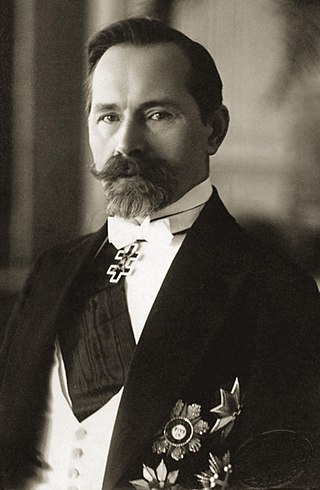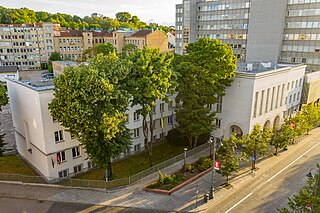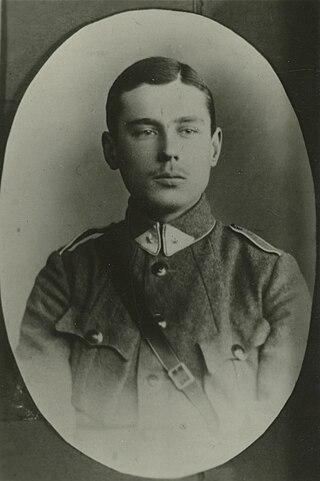
Antanas Smetona was a Lithuanian intellectual, journalist and politician who served as the first president of Lithuania from 1919 to 1920 and again from 1926 until the Soviet occupation of Lithuania in 1940. Referred to as the "Leader of the Nation" during his presidency, Smetona is recognised as one of the most important Lithuanian political figures between World War I and World War II, and a prominent ideologists of Lithuanian nationalism and the movement for national revival.
The State Council of Lithuania was a legislative institution in interwar Lithuania. It was an advisory institution that codified existing and proposed new laws. It was established by the constitution adopted on 15 May 1928. President Antanas Smetona dismissed the Third Seimas in March 1927. Although the constitution of 1928 retained the Seimas as the legislative body, new elections were not called until June 1936. In the absence of a parliament, the State Council performed some legislative functions of the Lithuanian government. It was liquidated on 26 July 1940 by the People's Government of Lithuania. Its chairman in 1928–1938 was Stasys Šilingas who became the prime legal architect of the authoritarian regime of Smetona. The archives of the council were lost after the Soviet occupation. Therefore, its activities are known mainly from the press, memoirs of its members, and documents of other institutions.

Vladas Mironas was a Lithuanian Catholic priest and politician. He was one of the twenty signatories of the Act of Independence of Lithuania and served as the Prime Minister of Lithuania from March 1938 to March 1939.

Constitutional Court of the Republic of Lithuania is the constitutional court of the Republic of Lithuania, established by the Constitution of the Republic of Lithuania of 1992. It began the activities after the adoption of the Law of Constitutional Court of the Republic of Lithuania on 3 February 1993. Since its inception, the court has been located in Vilnius.

The signatories of the Act of Independence of Lithuania were the twenty Lithuanian men who signed the Act of Independence of Lithuania on February 16, 1918. The signatories were elected to the Council of Lithuania by the Vilnius Conference in September 1917 and entrusted with the mission of establishing an independent Lithuanian state. The proclaimed independence was established only in late 1918, after Germany lost World War I and its troops retreated from Lithuanian territory. What followed was a long process of building the state, determining its borders, and gaining international diplomatic recognition. The signatories succeeded in their mission and independent Lithuania survived until the Soviet Union occupied the state on June 15, 1940.

The 1926 Lithuanian coup d'état was a military coup d'état in Lithuania that replaced the democratically elected government with a nationalist regime led by Antanas Smetona. The coup took place on 17 December 1926 and was largely organized by the military; Smetona's role remains the subject of debate. The coup brought the Lithuanian Nationalist Union, the most conservative party at the time, to power. Previously it had been a fairly new and insignificant nationalistic party. By 1926, its membership reached about 2,000 and it had won only three seats in the parliamentary elections. The Lithuanian Christian Democratic Party, the largest party in the Seimas at the time, collaborated with the military and provided constitutional legitimacy to the coup, but accepted no major posts in the new government and withdrew in May 1927. After the military handed power over to the civilian government, it ceased playing a direct role in political life.

The Third Seimas of Lithuania was the third parliament (Seimas) democratically elected in Lithuania after it declared independence on 16 February 1918. The elections took place on 8–10 May 1926. For the first time the Lithuanian Christian Democratic Party were forced to remain in opposition. The coalition government made some unpopular decisions and was sharply criticized. Regular Seimas work was interrupted by a military coup d'état in December 1926 when the democratically elected government was replaced with the authoritarian government of Antanas Smetona and Augustinas Voldemaras. The Third Seimas was dissolved on 12 March 1927 and new elections were not called until 1936.

Parliamentary elections were held in Lithuania between 8 and 10 May 1926. The Lithuanian Popular Peasants' Union remained the largest party, winning 24 of the 85 seats in the third Seimas. They formed a left-wing coalition government with the Social Democratic Party of Lithuania, which was overthrown in a military coup in December. The Seimas was disbanded in 1927 and Lithuanian Nationalist Union leader Antanas Smetona was appointed President.
The Lithuanian conferences during World War I refer to ten conferences held by Lithuanian activists during World War I in Switzerland and Sweden. They articulated the vision of independent Lithuanian state free of Russian, German, and Polish influence and as such were an important step towards the Act of Independence of Lithuania in February 1918.
The Farmers' Party was a liberal political party in inter-war Lithuania.

The Central Polish Electoral Committee was a political party in interwar Lithuania representing the Polish minority. The committee was organized in March 1920 and was the only ethnic minority party to win seats in all four democratic elections to the Seimas.

Juozas Balčikonis Gymnasium is a secondary state school located in Panevėžys, Lithuania. Teaching started in 1727, however, school reorganised to gymnasium in 1858, making it the oldest gymnasium type school in Lithuania. Juozo Balčikonio gimnazija is always one of the top-ranked institutions in the Lithuania for the high quality of its teaching, long lasting traditions and notable alumni.
Viltis was a Lithuanian-language newspaper published in Vilnius in 1907–1915 and 1991–1994. The newspapers was established in October 1907 by Antanas Smetona and Juozas Tumas-Vaižgantas. It promoted unity among Lithuanians attempting to bring together conservative Catholic clergy and more liberal intelligentsia. The newspaper concentrated on cultural matters as opposed to politics or news reports. It was supported by the clergy, but it was not a religious newspaper. Eventually, the clergy grew dissatisfied with the secular and moderate tone and Smetona left in 1913 to establish a separate newspaper Vairas. The intellectuals around Viltis became known as viltininkai and formed an early embryo of the Lithuanian Nationalist Union, the ruling party in Lithuania in 1926–1940. Viltis was discontinued due to World War I. It was briefly resurrected in the early 1990s by the Lithuanian Nationalist Union.
Vairas was a Lithuanian-language political and cultural newspaper published by Antanas Smetona and the Lithuanian Nationalist Union, the ruling party in Lithuania in 1926–1940. It was published three separate times. Vairas was first established in January 1914 when Smetona departed Viltis; it was discontinued due to World War I. The newspaper was briefly revived in September 1923 when Smetona and Augustinas Voldemaras harshly criticized their political opponents and the Lithuanian government. Due to the anti-government rhetoric, their newspapers were closed by state censors one after another, but they would quickly establish a new newspaper under a new title. Vairas was closed in February 1924. The newspaper was reestablished as a cultural magazine in 1929 with the backing of the authoritarian regime of Smetona. In 1939, it became a weekly political magazine that pushed an agenda of radical nationalism and openly sympathized with National Socialism. The magazine was discontinued after the Soviet occupation of Lithuania in June 1940.

Varniai concentration camp was an internment camp in Varniai, Lithuania. It was created a month after the coup d'état of December 1926 to house political prisoners, mostly members of the outlawed Communist Party of Lithuania. In total, more than 1,000 people passed through the camp before it was closed in 1931 due to financial difficulties brought by the Great Depression. Later, the authoritarian regime of Antanas Smetona operated two other internment camps, one in Dimitravas in 1936 and another in Pabradė in 1939.
The Tauragė Revolt was an anti-government revolt that took place in Tauragė, Lithuania on 9 September 1927. Members of the Social Democratic Party of Lithuania and Lithuanian Popular Peasants' Union wanted to remove President Antanas Smetona from power. The rebels took control of Tauragė, the revolt spread to neighboring villages and their forces grew to 200 men. However, the revolt was poorly prepared and was suppressed the same day by units of the Lithuanian Army that arrived from Klaipėda. In the aftermath, over 300 people were arrested and 11 were executed. A group of rebels escaped abroad where they became known as plečkaitininkai and, with the help from Poland, continued to plot against Smetona's regime until the mid-1930s. It was one of 13 attempts to overthrow Smetona's regime in 1926–1938.
Tauta was a Lithuanian-language newspaper published by the Party of National Progress in Kaunas, Lithuania from 19 November 1919 to 5 November 1920. It was a four-page newspaper published once or twice a week. In total, 65 issues appeared.

The Lithuanian Nationalist Union, also known as the Nationalists, was the ruling political party in Lithuania during the authoritarian regime of President Antanas Smetona from 1926 to 1940. The party was established in 1924 but was not popular. It came to power as a result of the December 1926 military coup. From 1927 to 1939, the Council of Ministers included only members of the LTS. In 1936, other parties were officially disbanded, leaving LTS the only legal party in the country. At the end of the 1930s new members started bringing in new ideas, right wing and closer to Italian Fascism. The party was disestablished after the Soviet occupation of Lithuania in June 1940. A party of the same name was reestablished in 1990 and claims to be the successor of the interwar LTS.

Stasys Putvinskis or Pūtvis was a Lithuanian military officer, agronomist, and politician. He served as the Minister of Agriculture in 1935–1938.

The farmers' strike in Suvalkija was a civil unrest in interwar Lithuania in 1935. It mostly affected Suvalkija where farmers demanded aid to help with a severe economic crisis.










